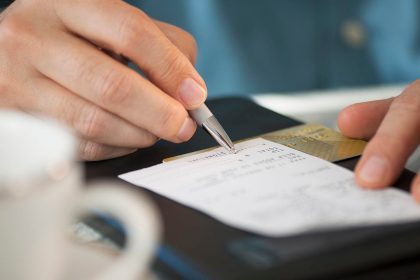I have praised flat-rate, no-annual-fee 2 percent cash back cards for a long time, but it wasn’t until last year that I added one to my personal wallet. I’ve always believed in the advice, I just didn’t take it myself for a long time — I guess I was like the shoemaker’s children who have no shoes.
Inflation was the straw that broke the camel’s back. I had a lightbulb moment as I was sitting on a cross-country flight to California in early 2023. I was tallying up how expensive it is to take our family of four on a trip like that, and I did a little back-of-the-envelope calculation. I finally decided to take the plunge, because I thought the card would earn my family an extra $1,000 over the course of the year. That felt too good to pass up.
Earning cash back rewards
My family ended up redeeming $1,202 in cash back from that card (the Wells Fargo Active CashⓇ Card) in 2023, exceeding my expectations. That included a $200 welcome bonus that is still available to new cardholders who spend $500 in their first three months with the card, as well as an average of about $100 per month during the 10 full months we had the card last year outside of the sign-up bonus.
Considering that almost all of this spending would have only earned 1 percent cash back on our other two credit cards, earning $1,000 in rebates as opposed to $500 put a significant amount of money back in our pockets. Many successful personal finance strategies revolve around making a good decision once and having it automatically repeat itself. Signing up for a card that doubled our return from 1 percent to 2 percent on most types of spending is a good example. It was easy to apply for the card; now we just use it and watch the extra money roll in every month.
Building our credit
Another benefit is that we signed up in my wife Chelsea’s name (I’m an authorized user on the card). This was a strategic decision meant to aid Chelsea’s credit score. Previously, Chelsea didn’t have any active credit in her own name and her credit score had slipped as old, closed accounts fell off her credit reports. Her credit score has jumped nearly 100 points since signing up for the card, from a “good” 720 to an “excellent” 814.
The Active Cash has become our workhorse credit card. Aside from a few key categories that we optimize on other cards (such as groceries and gas), we use the Active Cash for just about everything else.
In fact, we’ve used it so much lately that we had to ask for a higher credit limit. Expenses have been coming fast and furious lately, and earlier this month, we hit our $7,500 credit limit faster than we could pay it off. I always make sure to pay in full at the end of the month to avoid interest charges, but two sets of travel reservations and our daughters’ annual dance tuition all hit during the same week, so we asked for a higher credit limit to accommodate those charges.
A quick phone call to Wells Fargo’s customer service department resulted in a credit line that’s 76 percent higher. That meets our purchasing power needs and will also help our credit scores as long as we keep our usage in check (since having more available credit makes it easier to maintain a low credit utilization ratio, which helps your credit score).
Signing up for the Active Cash Card has helped my family in multiple key areas. We’re earning hundreds of dollars in extra cash back, and Chelsea’s credit score is substantially higher. This year, we’re on pace to earn about $1,800 in cash back on this card. In that case, getting 2 percent back instead of 1 percent will be worth an extra $900 over the course of the year.
Why I resisted 2 percent cash back cards at first
As recently as 2020, I had six personal credit cards. I decided that was too many for me — and it was definitely too many for Chelsea, with whom I share these accounts. She never liked juggling that many cards and struggled to keep track of which card offered the best rewards for various types of purchases, despite our attempts at coming up with a system to make it easier.
Back when I expanded to six cards, I started to stray from my no-annual-fee cash back roots to dabble in travel rewards cards that carry annual fees. It was terrible timing, because the COVID-19 pandemic erupted soon afterward and put the kibosh on travel for a while. I quickly decided that I didn’t want to pay annual fees on three different cards, especially given the circumstances. In 2021, I slimmed down to just two credit cards.
Even as my family returned to traveling in 2021 and 2022, we didn’t miss the cards that we canceled. We liked the simplicity of a two-card structure, and the two cards we used both suited our lifestyle very well.
For example, we get 6 percent cash back at U.S. supermarkets (up to $6,000 in annual purchases, then 1 percent) and 3 percent back on U.S. gas station purchases with the Blue Cash PreferredⓇ Card from American Express. And the Chase Freedom FlexSM* is best known for offering 5 percent cash back on rotating quarterly categories (up to $1,500 in quarterly spending, then 1 percent; activation required). Both cards also provide excellent customer service and other beneficial perks such as extended warranty coverage, travel insurance and a purchase protection benefit that once saved me $299.
I always knew it wasn’t ideal that many of our purchases earned only 1 percent cash back, but I rationalized it because I liked the cards we were using, and because life gets in the way sometimes. An object in motion stays in motion, in other words. You get busy with other things, and signing up for a new credit card isn’t always at the top of the priority list. But it’s not hard to do, and a few minutes’ worth of effort is paying off to the tune of several hundred dollars per year for my family.
The bottom line
Personal finance is very personal. While cash back cards have been a boon for me and my family, what works best for us may not be the best choice for you.
Regardless, you can follow the same blueprint while evaluating the best credit cards for your circumstances. Start by asking yourself whether or not you carry a balance on your cards, because if you have credit card debt, interest rates are high enough right now that it generally makes sense to seek the lowest rate, rather than chase rewards.
Beyond that, consider your top spending categories, what you want to get out of your rewards and how much complexity you’re willing to take on. The answers will shift over time. Since your lifestyle changes and the market does too, I think it’s a good idea to compare cards at least once a year. My opinion is that there’s a good place for a 2 percent no-annual-fee cash back card in just about every wallet.
Have a question about credit cards? Email me at [email protected] and I’d be happy to help.
The information about the Chase Freedom FlexSM has been collected independently by Bankrate. The card details have not been reviewed or approved by the issuer.
Read the full article here

















